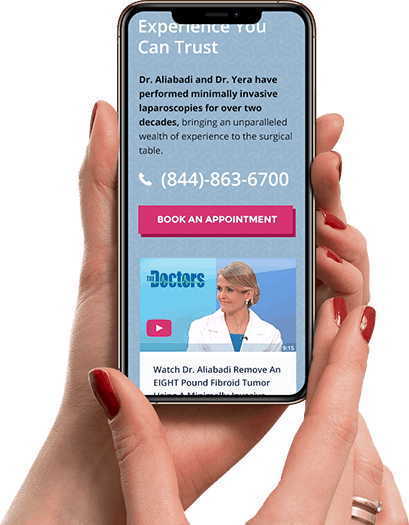If you have a uterus, you’re probably accustomed to the monthly discomfort, mood swings, bleeding, and cramps. About 10% of menstruating people experience pain so severe they can’t perform their daily activities.
Endometriosis — a chronic medical condition that affects the pelvic organs — can also cause bleeding and pain.
So, if you’re experiencing pelvic pain, how do you know if it’s period pain or endometriosis pain?

What causes menstrual pain?
Period pain refers to the discomfort and cramping some women experience during menstruation. This pain is typically felt in the lower abdomen and may be accompanied by other symptoms such as headaches, back pain, and nausea. Menstrual pain generally starts soon after your first period and gets better as you age.
If you’re experiencing severe pain during or around your period, consult with a gynecologist to uncover the cause of your excessively painful periods.
There are many conditions that can cause pelvic area pain and because many of their symptoms overlap it’s important to seek professional medical advice.
What does normal period pain feel like?
Menstrual cramps (as the name implies) are uncomfortable to painful cramps in the lower abdomen. The pain coincides with the onset of your period and may extend to your lower back or thighs. These cramps are caused by muscle contractions as your body expels the lining of the uterus.
Normal period pain is generally characterized by throbbing or cramping pain or dull abdominal pain.
If you’ve started having intense period pain or it disrupts your life every month, it may be a sign of something abnormal.
What does endometriosis pain feel like?
The most common symptom of endometriosis is pain. Because endometrial tissue (the lining of your uterus) spreads as part of endometriosis, the pain isn’t limited to the uterus. This endometrium-like tissue can grow on the fallopian tubes, the ovaries, the outside of the uterus, between the vagina and rectum, and sometimes even on the bowel and bladder or in the pelvic cavity.
Beyond pelvic pain, patients with endometriosis may experience:
- Intensely painful periods (dysmenorrhea)
- Pain during sexual intercourse (dyspareunia)
- Pain during bowel movements or urination
- Leg pain
- Back pain

Call 877-760-3564 or click here to schedule online
How to tell the difference between period pain and endometriosis pain?
The only way to know for sure if you have endometriosis is to talk to a healthcare provider. But if you’re experiencing pelvic pain, there are some things you can look for to figure out the cause of your pain.
Does pain management work?
Period pain generally responds well to over-the-counter pain medication such as ibuprofen. A heating pad can also help soothe your uterine contractions and reduce pain. If standard pain medication doesn’t reduce the pain to a manageable level, there may be another underlying problem — such as endometriosis.
Because endometrial tissue grows in response to your body’s hormonal cycle — just like the endometrial lining of the uterus — it can be controlled with hormone therapy. Hormonal contraceptives such as birth control pills can reduce both period pain and endometriosis pain.
What other symptoms are present?
Your menstrual period may be accompanied by premenstrual syndrome (PMS) symptoms such as mood swings, bloating, headache, low mood, insomnia, and food cravings.
Other signs of endometriosis may include:
- Constipation
- Painful sex
- Infertility
- Heavy menstrual bleeding
- Excessive bloating
- Headaches
- Irregular periods
Some of these are not easy to identify yourself (such as infertility) and others can overlap with PMS symptoms. But if you’ve recently developed heavy periods, that may be a sign of an underlying problem.
When does the pain occur?
Menstrual pain, as the name implies, occurs during your menstrual cycle. While endometriosis pain does often coincide with your menstrual cycle — because the endometrial tissue responds to your body’s hormonal cycle — it can also occur at other times of the month.
Medical diagnosis
The true way to differentiate between period pain and endometriosis is to see our OB/GYN. Not only can we review your medical history and symptoms, we can also perform a minimally invasive diagnostic test.
Using a laparoscope (a thin, lighted camera) inserted through a tiny incision, we can look inside the pelvic cavity for endometrial tissue.
Worried about pelvic pain? Talk to the Outpatient Hysterectomy Center!
Drs. Aliabadi and Yera are renowned masters of gynecology, obstetrics, and gynecological surgery. Patients travel from around the country to be treated at the Outpatient Hysterectomy Center, and Dr. Aliabadi even travels to teach her surgical expertise to other doctors.
OHC is committed to providing the best women’s health care; our staff chooses the least invasive treatment option whenever possible. With our minimally-invasive laparoscopic surgery, we can remove the endometrial tissue and resolve your pain and symptoms.
We invite you to establish care with the Outpatient Hysterectomy Center. Please make your appointment online or call us at (844) 863-6700.
The Outpatient Hysterectomy Center is conveniently located for patients residing throughout Southern California and the Los Angeles area. At the Cedars-Sinai Medical Center, we are near Beverly Hills, West Hollywood, Santa Monica, West Los Angeles, Culver City, Hollywood, Venice, Marina del Rey, Malibu, Manhattan Beach, and Downtown Los Angeles.











